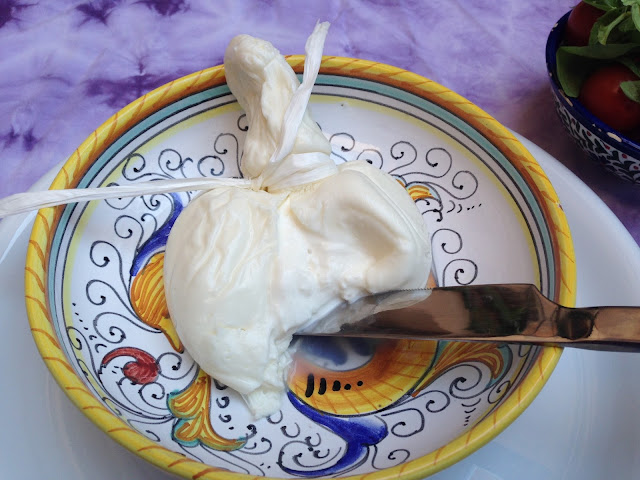It's become a newfangled menu staple in every Italian restaurant worth its sale, of late, and even higher-end specialty markets and Italian grocery stores sometimes carry it. But burrata is one food item that really benefits from being consumed in its area of production. And that's Puglia, Italy.
The WHAT: Let's first explain what burrata is, by explaining what it's not. This is not your ordinary mozzarella cheese. It has a creamy, liquid center that some people claim is melted butter, simply because the word in Italian translates to "buttered." It is not. It is, in fact, the "ritagli" or unspun curds from the mozzarella-making process, when the warm cheese is stretched into form. Instead of being formed into a ball, like mozzarella, the burrata is stretched into a pouch, and the ritagli and fresh cream are poured into the center of the pouch. It's then gathered at the top and pulled together like purse strings, and closed shut to keep the soft insides from spilling out. The original version is made with water buffalo milk (same as mozzarella di bufala), which has about 40% butterfat, and so is much more rich and flavorful than regular cow's milk. Believe me, this makes a HUGE difference, both in flavor and consistency. Once the burrata is formed, it's generally wrapped in a couple of leaves of the asphodel plant (cousin to the leek). The thinking here is that the leaves will only remain green as long as the burrata is fresh: generally advised, that's 24 hours, and after 48, the cheese is past its prime. This covers the WHEN.
Which brings us to the WHERE. This cheese comes from the region of Puglia, the heel of the boot of the Italian peninsula. In Rome, many shops would get supplies of fresh burrata trucked in every day, just as we'd get fresh mozzarella di bufala from the Campania region -- often still warm from the cheese-making process. I've tried burrata here in the States, on many occasions and from various producers, from numerous food markets and at several restaurants. It never even comes CLOSE to what I've eaten in Italy, and of course, specifically close to the source, in Puglia itself. Yes, large producers in the U.S., like BelGioioso (based in Wisconsin) approximate these Italian specialty cheeses. But they don't use buffalo milk for their burrata, and the mass-produced aspect is in great contrast to the artisanal process of its origin, as well-made as it may be.
So, my advice? Head to Italy for a taste of the real thing, burrata in its place of origin. Puglia is lovely this time of year...






Thanks D. Dawn thinks she's had 'real' Burrata and has never been to Puglia. I think the case is now closed.
ReplyDeleteBTW, is that last photo from Lecce?
Ha -- well, yes. You need to introduce her to the real thing. ;) Last photo is from Cisternino.
ReplyDelete